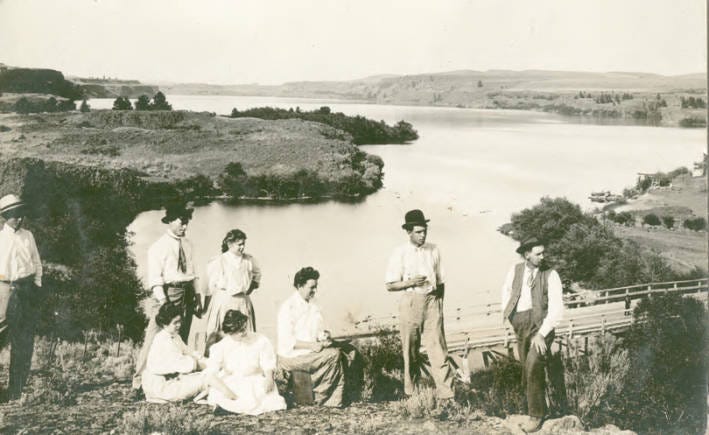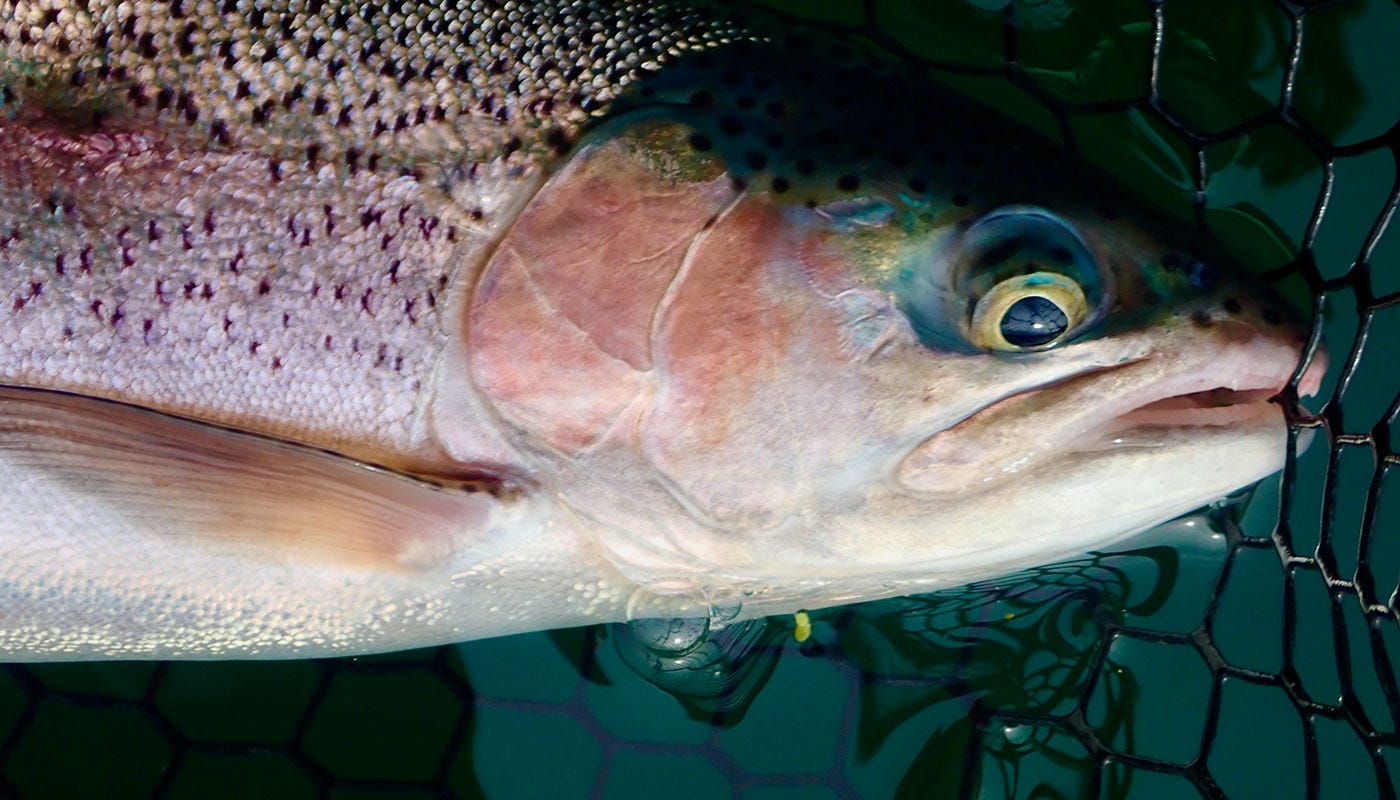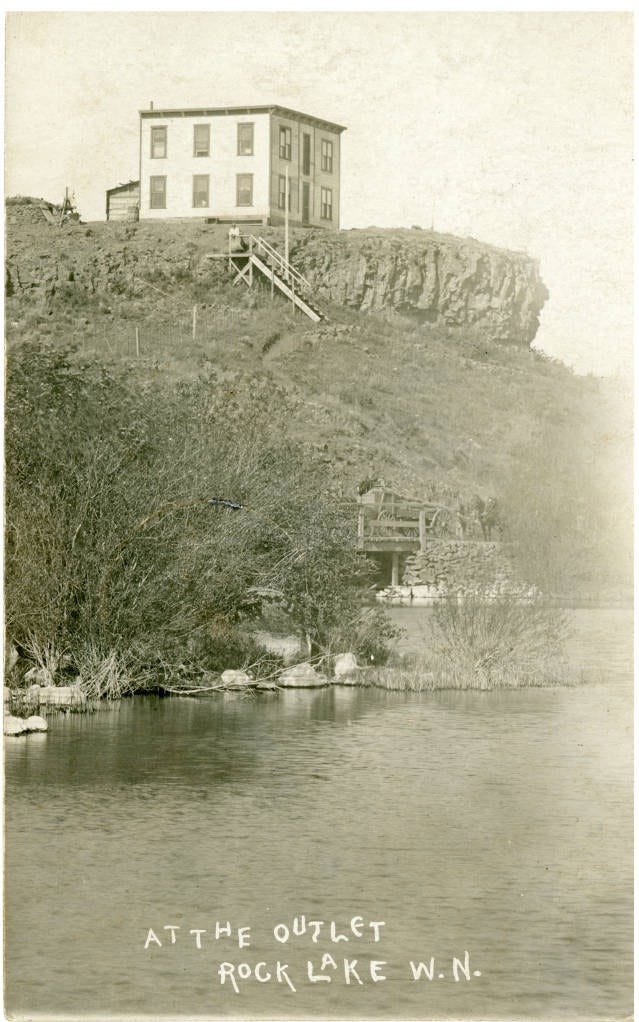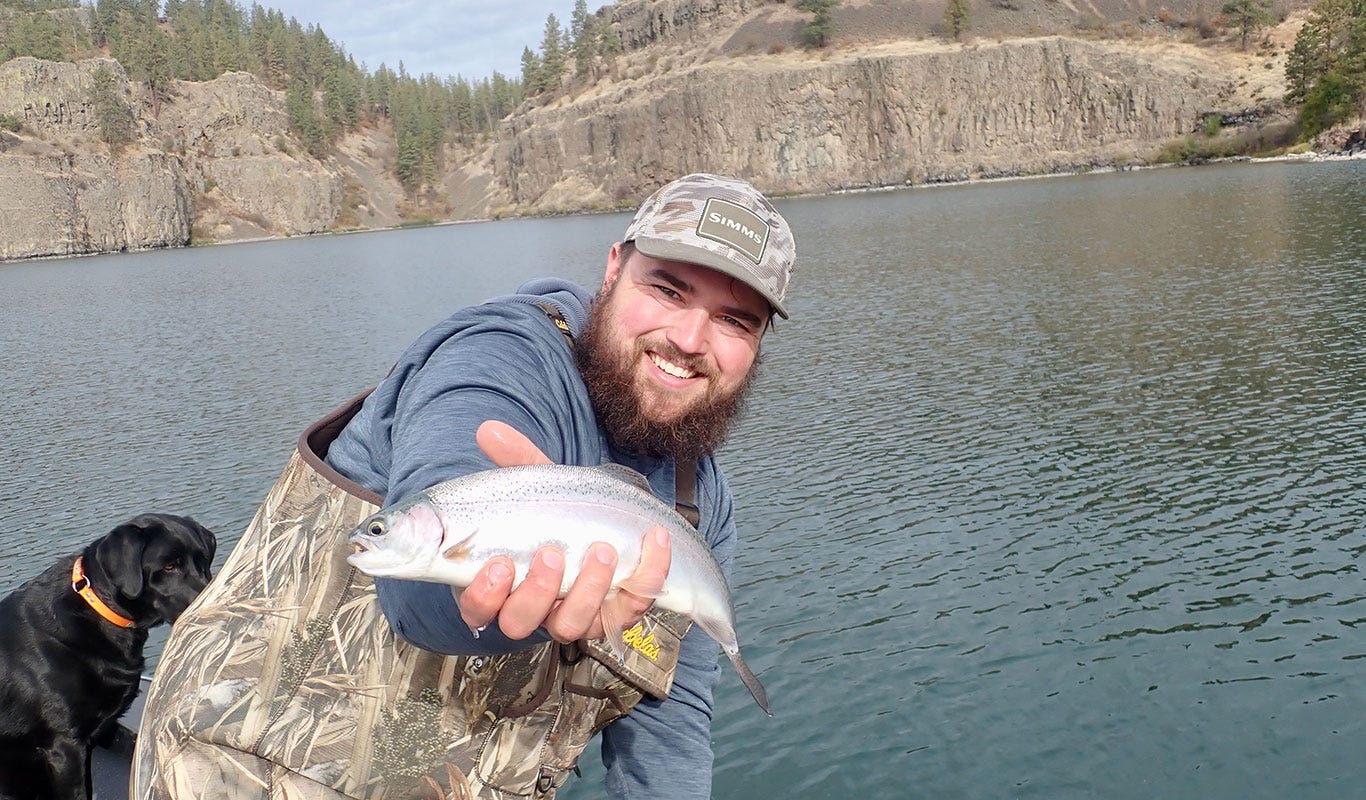Rock Lake (Eastern Washington) Dreams, Facts and Legends

RAINING RATTLESNAKES, GHOSTS, DEEPWATER MONSTERS
AND INCREDIBLE FISHING
It was getting past time for me to begin my Rock Lake presentation to a large fly fishing club, but people were still milling around socializing and swapping fish stories. I’d done every polite thing I could think of to get things started so, in frustration I bellowed “MY FAVORITE PLACE TO FISH IS…” The room went quiet.


OK, that part never happened, but it was part of a dream I once had. And as far as dreams go, it’s entirely opposite from my dream of catching a Rock Lake brown trout over ten pounds, which is a distinct possibility. Sorting through all the half-truths, tall tales and lurid stories about Rock Lake just to get to some facts can leave you dizzy. Here are a few facts for starters.
Rock is the largest, deepest Channeled Scabland lake in Eastern Washington. According to the Whitman County Library website, “the native Indians called Rock Lake ‘Never-Freezing-Water.’” It’s open to fishing year-round, which makes it the only area lake where you don’t have to drill a hole to fish during winter.
It’s about seven miles long and averages about a mile wide. Parts of the lake are over 300 feet deep and much of it is framed by vertical basalt walls hundreds of feet tall, and deep. There is only one public boat launch just above the bridge at the outflow (Rock Lake Road). Rock Creek threads in and out of the lake before eventually flowing into the Palouse River and then the Snake. There are no special angling regulations on Rock Lake, so the general harvest limit is five trout per day, flies, lures and bait are all permitted, and you can leave barbs on your hooks if you wish (but we don't).


THE FISHING
The list of fish species in Rock Lake is impressive. The lake has rainbow and brown trout, Kokanee salmon, black crappie, bluegills, both largemouth and smallmouth bass, brown bullhead, perch, and carp.
Here in the West Spokane House of Fly, we typically target the trout and carp. Unless you’re sight fishing for carp (which is awesome), expect to catch mainly rainbows. The browns are there sitting atop the Rock Lake food chain, but they aren’t as abundant or easy to catch as the rainbows.
The rainbow trout fishing isn’t particularly difficult. If you can chuck a nymph out there under a strike indicator, you’re probably going to catch fish. The other method is meat fishing, throwing big streamers on a full-sink fly line. For reliable flies, most of the patterns that work in other area lakes will also serve you well at Rock. Chironomids, balanced leeches, damsels, dragons, leech patterns, etc. will all catch fish. Most baitfish or sculpin patterns will also produce fish. Some days a beaded Crystal Bugger is all you need.
Aquatic insect activity is limited to those parts of the lake with the appropriate habitat. As long as there is something for insects to cling to (plants, rocks, mud, rock walls, etc.) and enough sunlight to generate the zooplankton and vegetable matter insects feed on, there ought to be bugs and fish nearby. Close to shore both nymphing and streamer fishing can be very effective. That doesn’t mean there aren’t plenty of fish cruising around out in the deep water, but these are generally meat-eaters. Streamers are the best bet further away from shore.


DOING THE NUMBERS
Washington Dept. of Fish & Wildlife does not stock Rock Lake with catchable-size trout, but rather smaller “Put, Grow and Take” rainbow trout, triploid rainbow trout, and brown trout. This year (2023) they’ve stocked 14,000 rainbows, 27,000 triploid rainbow trout, and 14,200 brown trout. Last year they stocked 257,000 rainbows and 83,000 brown trout, so there is no lack of trout in Rock Lake. Randy Osborn, District 2 Fish Biologist, estimates the rainbows in Rock make up 60-75 percent of the trout population, leaving 25-40 percent brown trout. But the browns are much harder to connect with.
Osborn described Rock Lake browns as the “bully on the block.” Being the apex predator in the system, they get to decide who gets eaten and who doesn’t. Browns in the 10-15 pound range have been landed at Rock, hence the whispers about Rock Lake possibly containing a potential new state record brown trout. The current Washington state record brown is 22 pounds from Sullivan Lake in Pond Orville County.
Carp spawn in the few shallow areas of the lake, sometimes more than once during the warmer months of spring and summer. Some of the shallow bays carp favor are fairly close to the boat launch, but remember the shore is private property. Please respect landowners rights and fish for these from a boat, pontoon or float tube. If you see tailing fish muddying up the water within casting distance, you’ve found gold. Cast past the fish, drag your fly as close as you can to the fish and drop your rod tip allowing the fly to settle on the bottom in front of the fish’s face. If the fish picks up your fly, hold on. These aquatic freight trains can take a while to land.
The inflow and outflow are obviously good places to fish. The outflow is the area adjacent to the boat launch ramp and is particularly popular with fly anglers lacking a serious powerboat. The inflow is seven miles from the boat launch ramp and, unless you have no regard whatsoever for personal safety, is reserved for anglers with access to a large powerboat. If there is any wind at all, don’t even think about it. The areas around the outflow offer more safety should things suddenly turn windy. If you’re in a small boat, pontoon or float tube and the wind starts kicking up, get the heck out of the water ASAP, period.


STAYING SAFE OUT THERE
Rock lake can, and will kill you if you’re not careful. The shape of the lake and vertical basalt walls up and down the lake easily produce a wind tunnel effect. The lake can go from glass to three-foot whitecaps in just a few minutes. Anglers in smaller boats a long way from shore can easily get swamped or capsized. Because of the abundant basalt walls there are plenty of areas where there is no place to get out of the water if you get into trouble. During cooler months hypothermia has also taken a major toll on unfortunates unable to find a place to climb out. Anglers have been forced to ride out the night clinging to rock walls waiting for the wind to die down so they can make it back to the boat launch. Don’t be that guy.
Thoroughly research the weather report before heading out to Rock, and force yourself to pay attention to the slightest changes while you are fishing. It could save your life.
Larger boats are encouraged to stay toward the middle of the lake, especially if they are trying to get up or down the lake in a hurry. Rock is famous (infamous?) for huge rock pinnacles that rise to just a few inches below the surface, especially along the eastern side of the lake. These have literally destroyed some boats.
LOOK OUT BELOWWWWWWW!
We had a customer in the shop this spring who said he’d been fishing Rock Lake for years. He'd discovered a fishing spot where he could tie his boat off to one of Rock’s basalt walls. What he’d failed to consider was that rattlesnakes occasionally slip off their sunny perches up above and land in the water.
No problem for the snake because they’re good swimmers, but it was a major problem for this guy whose boat happened to be in the way of the snake’s free fall. I imagine it may have sounded something like, PLOP… SH-SH-SH-SH-SH… MAN OVERBOARD! (I won’t describe how hard I laughed, but Depends might have helped.)
HISTORY
There isn’t much information on Rock Lake prior to the early 1900s, and it didn’t last long. In 1905 Willis Anson Evans heard the railroad was coming through and purchased land along the outflow of Rock Lake. Evans built a store, dance hall and small hotel/resort called Cliff House. Rooms rented for 75 cents per night, and Mrs. Evans’ meals were 35 cents each, or three for a buck. Railroad workers often dined at Cliff House while building the railroad trestle.
Back then the water in Rock was still potable, so water was supplied to Cliff House via a five-gallon bucket lowered into the lake by a rope from a special platform they’d built. Evans also built a 25-passenger steamboat and charged passengers to take them out on lake tours on Sunday afternoons.
The town of Rock Lake was never much of a going concern, a few buildings and another hotel. It was abandoned altogether after the 1910 flood. But it’s interesting to imagine what things might have been like. The rock precipice upon which Cliff House was built on is still clearly recognizable across the outflow from the boat launch, just downstream from the bridge on the right-hand side. You can also still see where the large railroad trestle used to be behind the town site. Cliff House was torn down between 1920 and 1922.
LEGENDS AND LORE
The Internet can provide all the lurid, fantastic tales you could ever want about Rock Lake. Indian legends were the first to claim there was something very large living in the depths of Rock Lake, a notion allegedly supported by some local landowners. Anglers with electronic fish finders claim to have picked up very large objects swimming around in the lake’s depths. Several have sworn something large bumped into the hull of their boats when over deep water. One guy said he was almost tossed out of his boat.
Legend also claims a load of brand-new Model T Fords were lost to the lake’s depths when it tumbled from a trestle. Another says a load of military staff cars met the same fate during WWII.
There was supposedly a local hotel that burned to the ground in two hours with people still inside. Some have claimed to hear distant player piano music and laughter over the lake at night, and even smell cigar smoke. Some claimed to have heard Native American drums and war cries. Others have heard distant railroad steam whistles from days gone by.
People have suggested there might be a “false bottom” in parts of the lake, making a subterranean connection with a vast underground aquifer. Some even speculate that’s why a number of the lake’s many drowning victims have never been recovered.
An Indian chief once allegedly put a curse on the lake which stated that at least one white man would die every year in the lake, a curse that has pretty much held true.


Rock Lake is certainly one of the more productive fisheries in Eastern Washington, and one of the most interesting. It can be dangerous, but careful consideration of weather conditions and constant vigilance will likely keep you out of trouble. Whether you’re pulling large streamers for rainbow trout, the next Washington state record brown trout or sight fishing for the lake’s massive carp, any number of large underwater creatures might very well pull back. While the legends and lore of Rock Lake may seem to outpace what we know for sure about Rock Lake, it's a fact that it's a fabulous fishery if you play by her rules.



